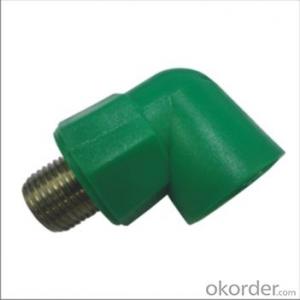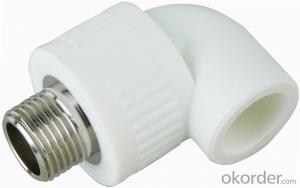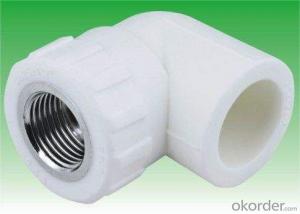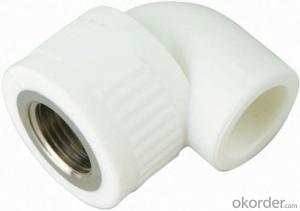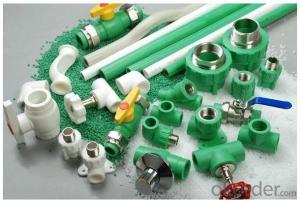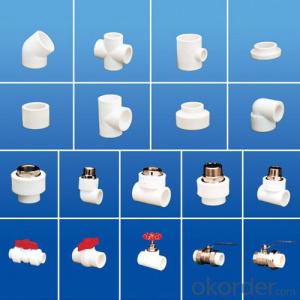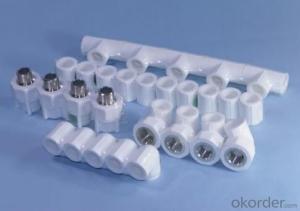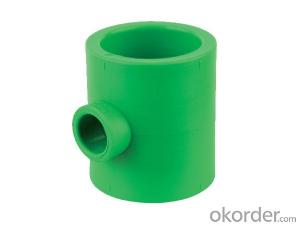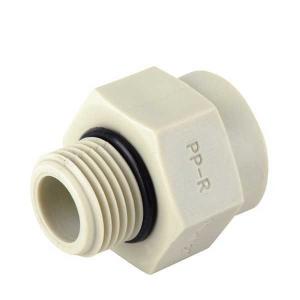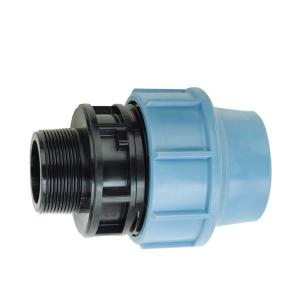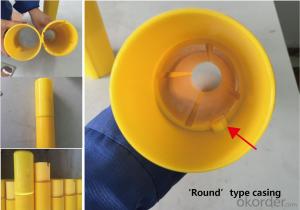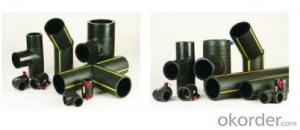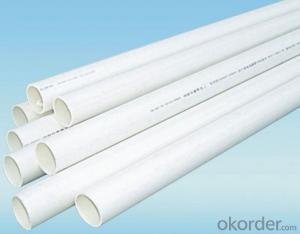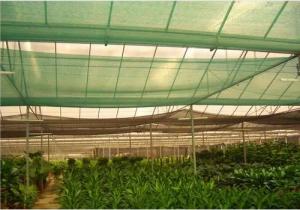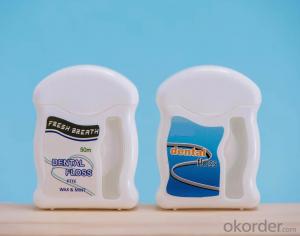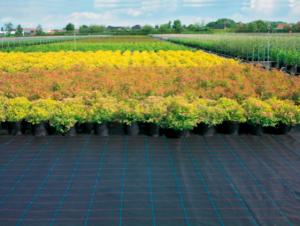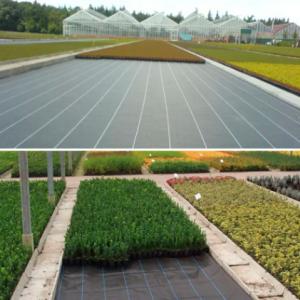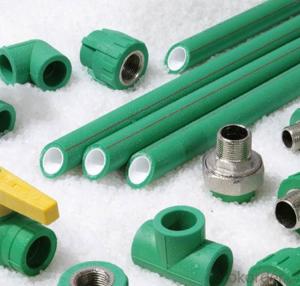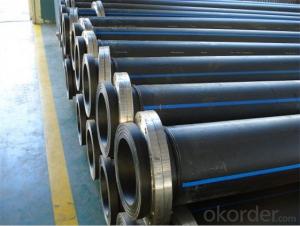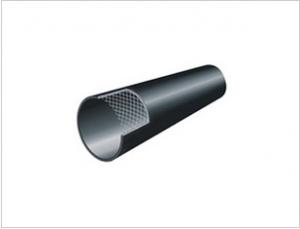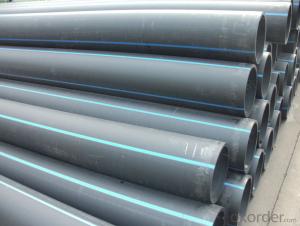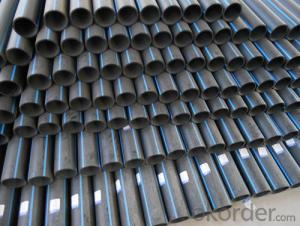China New PPR Elbow for Hot and Cold Water Conveyance with Safety Guaranty
- Loading Port:
- Dalian
- Payment Terms:
- TT OR LC
- Min Order Qty:
- 1000 pc
- Supply Capability:
- 100000 pc/month
OKorder Service Pledge
OKorder Financial Service
You Might Also Like
Quick Details
Material: Plastic
Technics: injection
Place of Origin: China (Mainland)
Connection: Welding
Head Code: round
Color: white
Advantages
1)Light weight, convenient to transport and handle
2)High strength
3)less resistance
4)Corrosion resistance
5)Sound insulation
6)Easy to install
7)long lifespan
8)low cost
9)Recyclable: thereby benefiting the environment
10)OEM/ODM welcome standards
11)Reliable installation
Product Description
Pressure | Size(mm) | Pressure | Size(mm) |
PN1.25MPA | 20*2.0 |
PN1.6MPA | 20*2.3 |
25*2.3 | 25*2.8 | ||
32*2.9 | 32*3.6 | ||
40*3.7 | 40*4.5 | ||
50*4.6 | 50*5.6 | ||
63*5.8 | 63*7.1 | ||
75*6.8 | 75*8.4 | ||
90*8.2 | 90*10.1 | ||
110*10.0 | 110*12.3 |
Product Show


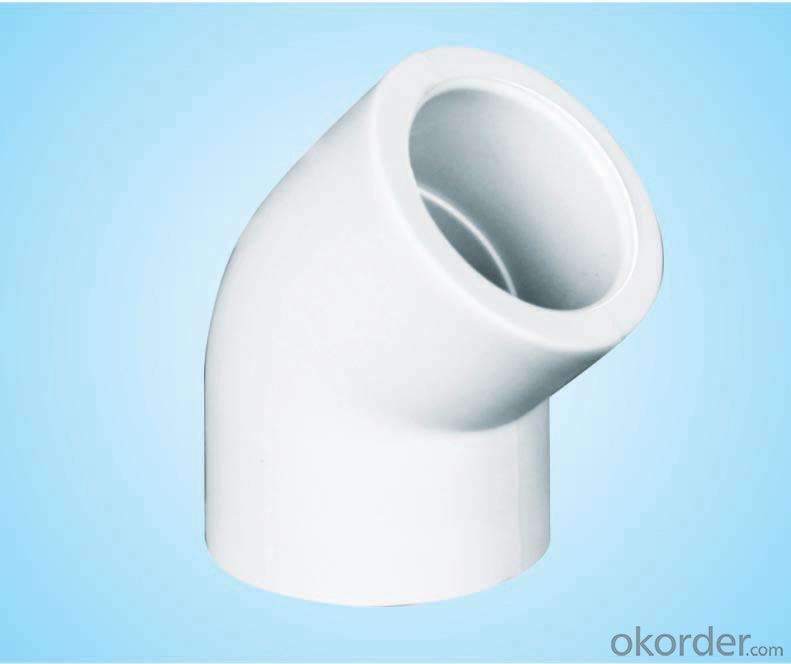
Advantages
1.We named this kind of fittings as PPR reducing sleeve. ppr reducing coupling
2.A whole part of this PPR reducing sleeve is made of polypropylene.
3.As you know, all the fitting designed for connecting the pipe or change the piping path. This PPR reducing sleeve is able to connect the different diameter pipeline together. I believe you know how to use it.
4.All of these PPR pipe fitting come in 3 different colors: white, gray, green.
5.Our PPR pipe fitting had been pasted the ISO9001 authentication. And had been got the CE certification.
6.These PPR reducing sleeve makes use of completely 100% new PPR material import from Korea. To be ensured that it is much healthier than the pipe make use of the reclaim plastic.
7.We adopt the newest technology in the piping produce industry.
8.We had been piping manufacturer for over 10 years. And we are good at this
Company Information
CNBM International Corporation (CNBM International) is the most important trading platform of CNBM Group Corporation, a state-owned company under the direct supervision of State-owned Assets Supervision and Administration Commission of the State Council.
CNBM International is highly recognized by its business partners and clients all over the world and has obtained rapid development under the spirit of win-win. We will carry on the mutual beneficial, innovative and revolutionary trading structure as we did before, create value for our employees, share holders and clients and benefit the whole society in our future development
- Q:Are plastic pipe fittings suitable for laboratory installations?
- Yes, plastic pipe fittings can be suitable for laboratory installations. They are commonly used in laboratories due to their corrosion resistance, chemical compatibility, and ease of installation. However, the suitability of plastic pipe fittings may vary depending on the specific requirements and chemicals involved in the laboratory setup. It is important to consider factors such as pressure ratings, temperature limitations, and the type of chemicals being transported before selecting plastic pipe fittings for laboratory installations.
- Q:Are plastic pipe fittings compatible with flange connections?
- No, plastic pipe fittings are not generally compatible with flange connections. Flange connections are typically used for joining metal pipes, while plastic pipe fittings are designed for use with plastic pipes and utilize different connection methods, such as solvent welding or compression fittings.
- Q:Can plastic pipe fittings be used for stormwater infiltration systems?
- Yes, plastic pipe fittings can be used for stormwater infiltration systems. Plastic pipe fittings, such as those made from PVC or HDPE, are commonly used in stormwater management systems due to their durability, corrosion resistance, and ease of installation. These fittings can effectively connect and redirect stormwater runoff to infiltration systems, allowing for efficient drainage and groundwater recharge.
- Q:Can plastic pipe fittings be used for industrial waste disposal systems?
- Yes, plastic pipe fittings can be used for industrial waste disposal systems. Plastic pipe fittings, such as PVC or CPVC, are commonly used in various industrial applications due to their resistance to chemicals and corrosion. They are durable, cost-effective, and provide a reliable solution for managing industrial waste disposal systems.
- Q:Can plastic pipe fittings be used for gas piping?
- No, plastic pipe fittings should not be used for gas piping. Gas piping requires materials that are specifically designed and approved for gas applications, such as steel or copper fittings, due to the safety risks associated with gas leaks and potential fire hazards.
- Q:Can plastic pipe fittings be used for industrial applications?
- Yes, plastic pipe fittings can be used for industrial applications. Plastic pipe fittings are durable, lightweight, and resistant to corrosion, making them suitable for various industrial settings. They are commonly used in industries such as chemical processing, water treatment, and HVAC systems. Additionally, plastic pipe fittings can offer cost savings compared to traditional metal fittings, making them a popular choice in many industrial applications.
- Q:How do plastic pipe fittings compare to CPVC fittings?
- Plastic pipe fittings and CPVC fittings have some similarities, but they also have notable differences. Plastic pipe fittings, which are usually made of PVC (Polyvinyl Chloride), are known for their durability and affordability. They are widely used for various applications, including plumbing, irrigation, and drainage systems. Plastic fittings are resistant to corrosion, chemicals, and UV radiation, making them suitable for both indoor and outdoor installations. However, they may not handle high temperatures as well as CPVC fittings. On the other hand, CPVC (Chlorinated Polyvinyl Chloride) fittings are specifically designed for hot water applications. They can withstand higher temperatures than plastic fittings without losing their structural integrity. CPVC fittings offer excellent heat resistance, making them ideal for hot water supply lines in residential and commercial buildings. However, compared to plastic fittings, CPVC fittings can be slightly more expensive. In summary, while plastic pipe fittings are versatile and cost-effective, CPVC fittings are better suited for hot water applications where higher temperatures are involved. The choice between the two depends on the specific requirements of the plumbing project.
- Q:Can plastic pipe fittings be used in storm drain systems?
- Yes, plastic pipe fittings can be used in storm drain systems. They are commonly used due to their durability, corrosion resistance, and affordability. Plastic fittings are available in various sizes and configurations, making them suitable for different storm drain system requirements.
- Q:Can plastic pipe fittings be used for wastewater disinfection systems?
- No, plastic pipe fittings are not recommended for wastewater disinfection systems as they may not be able to withstand the chemical disinfectants used in these systems and could potentially degrade or fail over time.
- Q:What tools and methods are needed for the installation of plastic hoses and steel tubes?
- Because of the linear expansion of PVC - U drainage pipe, the temperature expansion is larger. In the installation of drainage risers. To install expansion joints, but how to install, and what part of the installation, the construction unit is notVery clear. At the same time in the construction of cross branch often is not properly installed or not installed bellows expansion joint, and in accordance with the specifications, drainage cross branch, stem straight pipe, ventilation pipe, circular ventilation tube apparatus and ventilation pipe on the confluence confluence no greater than 2 m, should be set expansion joints, and horizontal drainage the branch should set up special expansion joint. And the maximum spacing of retractable joints shall not exceed 4 M.
1. Manufacturer Overview |
|
|---|---|
| Location | |
| Year Established | |
| Annual Output Value | |
| Main Markets | |
| Company Certifications | |
2. Manufacturer Certificates |
|
|---|---|
| a) Certification Name | |
| Range | |
| Reference | |
| Validity Period | |
3. Manufacturer Capability |
|
|---|---|
| a)Trade Capacity | |
| Nearest Port | |
| Export Percentage | |
| No.of Employees in Trade Department | |
| Language Spoken: | |
| b)Factory Information | |
| Factory Size: | |
| No. of Production Lines | |
| Contract Manufacturing | |
| Product Price Range | |
Send your message to us
China New PPR Elbow for Hot and Cold Water Conveyance with Safety Guaranty
- Loading Port:
- Dalian
- Payment Terms:
- TT OR LC
- Min Order Qty:
- 1000 pc
- Supply Capability:
- 100000 pc/month
OKorder Service Pledge
OKorder Financial Service
Similar products
New products
Hot products
Related keywords
